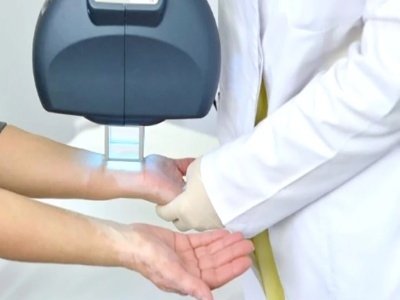Vitiligo - Laser Treatment
- Home/Clinical Dermatology/Vitiligo – Laser Treatment
Vitiligo - Laser Treatment

Laser Treatment for Vitiligo Treatment: Advanced Solutions for Even Skin Tone :
Introduction to Vitiligo Laser Treatment:
Vitiligo is a skin condition characterized by the loss of pigment, resulting in white patches on different areas of the body. Although it is not harmful or contagious, vitiligo can affect a person’s self-esteem. With advancements in dermatological treatments, effective solutions are available to manage and even out skin tone.
What Is Vitiligo?
Vitiligo occurs when melanocytes, the cells responsible for producing skin pigment, stop functioning or die. This leads to the appearance of depigmented patches on the skin.
Types of Vitiligo:
- Generalized Vitiligo: The most common form, affecting multiple areas on both sides of the body.
- Segmental Vitiligo: Appears on one side or part of the body.
- Focal Vitiligo: Limited to a few areas.
- Mucosal Vitiligo: Affects the mucous membranes, such as the lips.
- Trichrome Vitiligo: Features patches of varying color intensity.
Laser Treatment for Vitiligo
Laser therapy, particularly excimer laser treatment, has proven effective in re-pigmenting vitiligo-affected skin.
How It Works: The excimer laser emits a specific wavelength of UVB light that stimulates melanocytes, encouraging pigment production in depigmented areas.
Steps Involved:
- Consultation: The dermatologist assesses the vitiligo’s extent and determines if laser therapy is appropriate.
- Preparation: The affected skin is cleansed, and protective eyewear is provided.
- Laser Application: The laser is directed at the depigmented patches, stimulating pigment restoration.
- Post-Treatment Care: Patients may be advised to apply moisturizers and avoid direct sun exposure.
Benefits of Laser Treatment for Vitiligo
- Targeted Treatment: Focuses on specific depigmented areas.
- Non-Invasive: No incisions or downtime.
- Stimulates Pigmentation: Encourages melanocyte activity.
- Quick Sessions: Treatments typically last 15 to 30 minutes.
Other Treatment Options
- Topical Corticosteroids: Help reduce inflammation and stimulate pigmentation.
- Phototherapy: Exposure to controlled UVB light.
- Skin Grafting: Transplanting healthy skin to depigmented areas.
- Depigmentation Therapy: For widespread vitiligo, this involves lightening the remaining pigmented skin.
What to Expect During Recovery
After laser treatment, slight redness or sensitivity may occur but usually resolves quickly. Following dermatologist recommendations, including sun protection, is essential for optimal results.
Why Choose Dermatological Care for Vitiligo?
A personalized and expert approach is crucial for managing vitiligo. Dermatologists can provide comprehensive care, including advanced treatments like laser therapy, to help patients achieve a more even skin tone and improved confidence.
Conclusion
Living with vitiligo can be challenging, but modern treatments offer hope. Laser therapy, along with other dermatological solutions, provides effective options for restoring skin pigmentation.
If you are seeking treatment for vitiligo, consult us to explore personalized care options.
